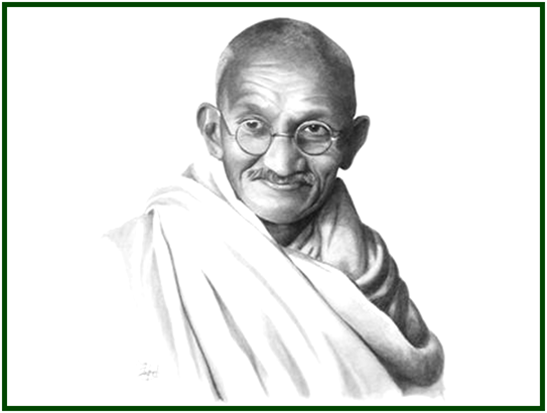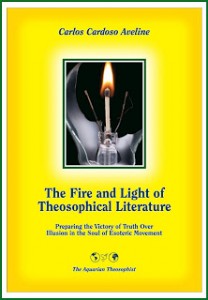
Indian Leader Had Direct
Contact With the Esoteric Movement
Carlos Cardoso Aveline

Mohandas Gandhi identified both truth
and falsehood in the theosophical movement
“Our scriptures have declared
that there is no dharma higher than truth.”
Mohandas Gandhi [1]
“The soul of religions is one, but it is encased in a
multitude of forms. The latter will endure to the
end of time. Wise men will ignore the outward crust and
see the same soul living under a variety of crusts. (…..)
Truth is the exclusive property of no single scripture.”
Mahatma Gandhi [2]
Mohandas “Mahatma” Gandhi first heard of Theosophy when Helena P. Blavatsky lived in London.
Although Gandhi was a Hindu, his interest in Hinduism was only started through his contact with theosophists. He writes about it in Chapter 20 of his Autobiography:
“Towards the end of my second year in England I came across two Theosophists, brothers, and both unmarried. They talked to me about the [Bhagavad] Gita. They were reading Sir Edwin Arnold’s translation – The Song Celestial – and they invited me to read the original with them. I felt ashamed, as I had read the divine poem neither in Sanskrit nor in Gujarati. I was constrained to tell them that I had not read the Gita, but that I would gladly read it with them, and that though my knowledge of Sanskrit was meagre, still I hoped to be able to understand the original to the extent of telling where the translation failed to bring out the meaning. I began reading the Gita with them. The verses in the second chapter (…..) made a deep impression in my mind, and they still ring in my ears. The book struck me as one of priceless worth. The impression has ever since been growing on me with the result that I regard it as the book par excellence for the knowledge of truth.” [3]
A few lines later in his Autobiography, Gandhi says that he visited the Blavatsky Lodge of the theosophical movement in London and was personally introduced to Helena P. Blavatsky. And he writes:
“I recall having read, at the brothers’ instance, Madame Blavatsky’s Key to Theosophy. This book stimulated in me the desire to read books on Hinduism, and disabused me of the notion fostered by the missionaries that Hinduism was rife with superstition.”
In 1911, two decades after the death of H.P. Blavatsky, Annie Besant had taken political power in the Adyar Theosophical Society and abandoned the original theosophy. By that time Gandhi had already arrived to a firm position with regard to the new situation in the theosophical movement. With his characteristic frankness, the leader of the movement for India’s independence described what he thought about Annie Besant’s work, after she had left true esoteric philosophy aside.
He expressed himself in clear words:
“I do not think that Mrs. Besant is a hypocrite; she is credulous and she is duped by Leadbeater. When an Englishman suggested to me to read Leadbeater’s The Life After Death, I flatly refused to do so as I had grown suspicious of him after reading his other writings. As to his humbug, I came to know of it later.” [4]
Gandhi says Mrs. Besant was credulous and not a hypocrite. The sentence makes one remember the opening sentences in the famous 1900 letter, which a Master of the Wisdom wrote to Annie Besant:
“Says a Tibetan proverb ‘credulity breeds credulity and ends in hypocrisy’.” [5]
Thus the Master clarifies that credulity and hypocrisy often occur together, for one leads to the other. In fact, the history of the theosophical movement has been confirming this statement ever since 1900. Yet history has also confirmed the axiom according to which, since nothing in the universe is eternal as a separate form, no illusion or power manipulation can last beyond its “time of validity”. When the time comes, truth is unveiled.
The Fraternity of Religions
Mahatma Gandhi rejected pseudo-theosophy, but he kept his admiration for the authentic theosophical philosophy.
In 1939, Mrs. Sophia Wadia, one of the most significant leaders of the United Lodge of Theosophists (U.L.T.) in India, had her book “The Brotherhood of Religions” published. In the Foreword to the work, Mahatma Gandhi wrote:
“These essays of Sophia Wadia show at a glance how much similarity there is between the principal faiths of the earth in the fundamentals of life. All our mutual quarrels centre round non-essentials. Sophia Wadia’s labours will be amply rewarded if people belonging to different faiths will study faiths other than their own, with the same reverence that she has exhibited in her essays. An understanding knowledge of and respect for the great faiths of the world is the foundation of true Theosophy (….).” [6]
The affinity between Gandhi’s philosophy and the authentic esoteric philosophy is deep. Gandhi called his social struggle in India “Satyagraha”, a word which can be translated as “firmness in truth”.
His ashram – community of people who search for universal wisdom – was called Satyagraha. He also wrote that truth was the reason for the ashram’s existence. [7]
On the other hand, the motto of the theosophical movement is – since its foundation in 1875 – “There is no Religion higher than Truth.” As H.P. Blavatsky wrote in the first paragraphs of “The Key to Theosophy”, theosophists are “Philaletheians”, or “friends of truth”.
And Gandhi says:
“The soul of religions is one, but it is encased in a multitude of forms. The latter will endure to the end of time. Wise men will ignore the outward crust and see the same soul living under a variety of crusts. (…..) Truth is the exclusive property of no single scripture. We may call ourselves Christians, Hindus or Mohammedans. Whatever we may be, beneath that diversity there is a oneness which is unmistakable and underneath many religions there is also one religion.” [8]
NOTES:
[1] “All Men Are Brothers”, Life and Thoughts of Mahatma Gandhi, As Told In His Own Words, UNESCO (United Nations), Paris, 1958, 196 pp., see p. 47.
[2] “The Message of Mahatma Gandhi”, compiled and edited by U.S. Mohan Rao, Publications Division, Ministry of Information and Broadcasting, Government of India, 1968, New Delhi, 136 pp., see p. 38.
[3] “An Autobiography – or The Story of My Experiments with Truth”, M. K. Gandhi, Penguin Books, London, 1982, 454 pp., see chapter 20 of Part I, pp. 76-77.
[4] “The Collected Works of Mahatma Gandhi”, vol. XI, letter to Dr. Pranjivan Mehta, dated 08 May 1911. These sentences are quoted by Gregory Tillett in his book “The Elder Brother”, a biography of Charles Webster Leadbeater, Routledge & Kegan Paul, London, Boston, Melbourne & Henley, 1982, 338 pp., see p. 07.
[5] “Letters From the Masters of the Wisdom”, first series, transcribed and compiled by C. Jinarajadasa, TPH, India, 1973, 183 pp., see letter 46, p. 99.
[6] “The Brotherhood of Religions”, Sophia Wadia, Asian Book Trust, in Association with Theosophy Co. (India), Bombay, 1996, 171 pp., see p. 03. This 1996 edition has also a Foreword by the XIV Dalai Lama.
[7] “Cartas ao Ashram” (Letters to the Ashram), by Gandhi, Editora Hemus, São Paulo city, Brazil, 124 pp., see p. 25. Original edition in French, “Lettres à L’Ashram”, copyright Jean Herbert.
[8] “The Message of Mahatma Gandhi”, compiled and edited by U.S. Mohan Rao, Ministry of Information and Broadcasting, Government of India, 1968, New Delhi, see p. 38.
000
On the role of the esoteric movement in the ethical awakening of mankind during the 21st century, see the book “The Fire and Light of Theosophical Literature”, by Carlos Cardoso Aveline.

Published in 2013 by The Aquarian Theosophist, the volume has 255 pages and can be obtained through Amazon Books.
000